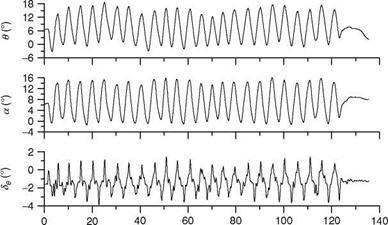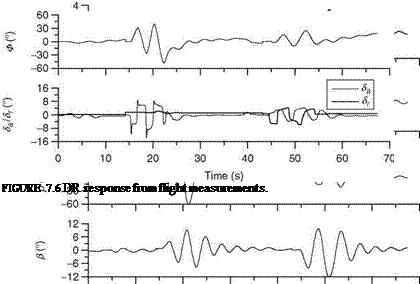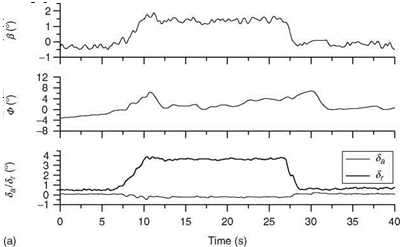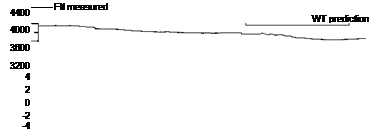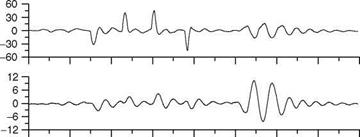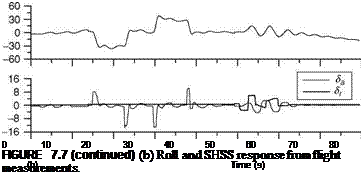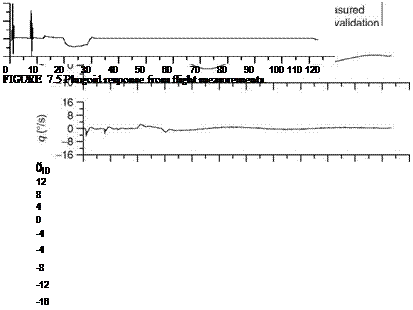Specific command inputs are required to conduct certain maneuvers, the data from which are used for parameter estimation or drag polar determination.
7.5.1 Design Consideration for Input Signals
The responses of an aircraft to a pilot’s (or computer’s) command signal are the flight data that along with other mandatory data (mass, inertia, dynamic pressure, etc.) are used in a parameter-estimation procedure to estimate the aerodynamic derivatives. These responses are generated by exciting certain modes of the aircraft. These dynamic modes contain information on the aerodynamic derivatives implicitly. Thus, it is very essential to choose input test signals with good characteristics so that properly excited dynamic responses are available for further analysis. The test input signal must possess certain desirable features [1,7]: (1) it should have sufficient bandwidth to excite the modes of interest, (2) the amplitude and form of the signal should be sufficient to yield good quality maneuvers, (3) the amplitude, bandwidth, and slope of the signal should be bounded so that aircraft motion does not violate the assumption of linearity, and (4) it should be possible for the pilot to realize (or generate) the signal easily. Of course, for difficult signals computergenerated input signals can be used.
Different types of input signals that have certain desirable attributes are [7] (1) a doublet signal excites a band at a higher frequency, the response is not unidirectional, and it is easy to generate by a pilot, (2) a 3-2-1-1 signal has a relatively broadband spectrum, can effectively excite over a decade of frequency, and it is also easy for a pilot to generate with some practice, (3) the Schulz input signal is designed by maximizing the trace of Fisher information matrix (FIM, Chapter 9), relatively higher frequencies are missing in it, might give relatively large standard deviations compared to the next two signals, and is not so easy to generate by a pilot, (4) the DUT (Delft University of Technology) input signal is designed by minimizing the trace of estimation error covariance matrix P, is a reasonably good signal, and is not so easy to generate by a pilot, and (5) the Mehra input signal is designed by maximizing the determinant of FIM in frequency domain, is a reasonably good signal, and is not so easy to generate by a pilot. For a given case study the 3-2-1-1, DUT, and Mehra input signals were found to be of similar efficiency [7]. Many of these signals can easily be generated only by a computer or a flight test panel. The subject matter of the design of test signals for parameter estimation is relatively complex and requires considerable mathematical sophistication. Hence, only some important aspects of the design procedures are highlighted here.
In order to design a multistep input signal, which will excite the modes of an aircraft, one can use the Bode diagram approach [7]. This allows one to select the frequencies to be included in the signal based on the identifiability of the derivatives. Let the longitudinal motion be described as
U + gU — Xuu — Xa • a = 0
a q Zuu Za • a Zdede 0
q — Mui — Maa — Mq q — MSe de = 0
The frequency response magnitudes of the terms in the above equations could be plotted as a function of the input signal frequency. Based on this analysis, a derivative is considered identifiable when its term has a magnitude of at least 10% of the largest term’s magnitude. This approach is intuitively appealing. There are other approaches based on (1) minimization of the estimation error variance of the parameters by means of an appropriate choice of input signal characteristics subject to energy constraints, (2) maximization of the trace of the FIM, (3) minimization of the trace of the estimation error covariance matrix, and (4) the determinant of the FIM.
The required input signal should be generated either manually by a pilot or by some automated technique. In the former case, the pilot flying the test aircraft gives a command by practicing it several times to obtain a good quality signal in terms of its form and amplitude. The signal thus generated may not be a perfect one but if it has acquired adequate characteristics then it is acceptable. In essence, it must be able to excite the modes of the aircraft. In order to obtain accurate signal characteristics one can use electronics or computer means; thereby, it may also be possible to automate the generation of the signal. A pregenerated/prerecorded signal can be replayed during the test schedule. While using automatic means for generating and applying the input signal, care should be taken to assure that, in case of any exigency, the pilot is able to take over the control of the vehicle. There should be a mechanism to shut off the automatic application very quickly if so desired and revert to the manual mode of control.
7.5.2 Specific Input Types
Some specific input signals are shown in Figure 7.3. A doublet stick/rudder pedal input signal excites a band at a relatively higher frequency. It is used to excite longitudinal/LD short-period modes. It is applied to the aircraft control surface through pilot’s pitch, roll-stick, and rudder pedals. At the end of the input, the controls are held constant for some time to permit the natural response of the aircraft to be recorded. When applied to ailerons, it excites the rolling motion, which can be analyzed to obtain derivatives for roll damping and aileron control effectiveness. A similar test signal can be used for the rudder surface to determine yaw derivatives and rudder effectiveness. If the natural frequency шп of the mode to be excited is approximately known, then the duration of the time unit At for a doublet can be determined as At ffi 1.5/v„ s.
A 3-2-1-1 type is a series of alternating step inputs with the time duration of the steps satisfying the ratio 3:2:1:1. This input signal has power spread over a wider frequency band than the doublet power spectrum. The aircraft short-period longitudinal motion can be produced by applying 3-2-1-1 input to the elevator. The time unit At needs to be selected appropriately to generate sufficient excitation in the aircraft modes of motion.
A step input signal has energy at a relatively lower band of frequencies and is not very suitable for system identification purposes. A longer duration pulse (of 10-15 s) can be applied to the pitch stick/elevator to excite the longitudinal phugoid motion of the aircraft. The responses should be recorded for a sufficient number of cycles before retrimming. From these responses, one can estimate speed-related derivatives and phugoid damping and frequency. The doublet inputs tend to excite only a narrow band of frequencies. The pulse inputs have power at low frequencies and therefore suitable for exciting only low-frequency modes of the system. A combination of various input forms is generally considered the best for proper excitation of the aircraft modes.












